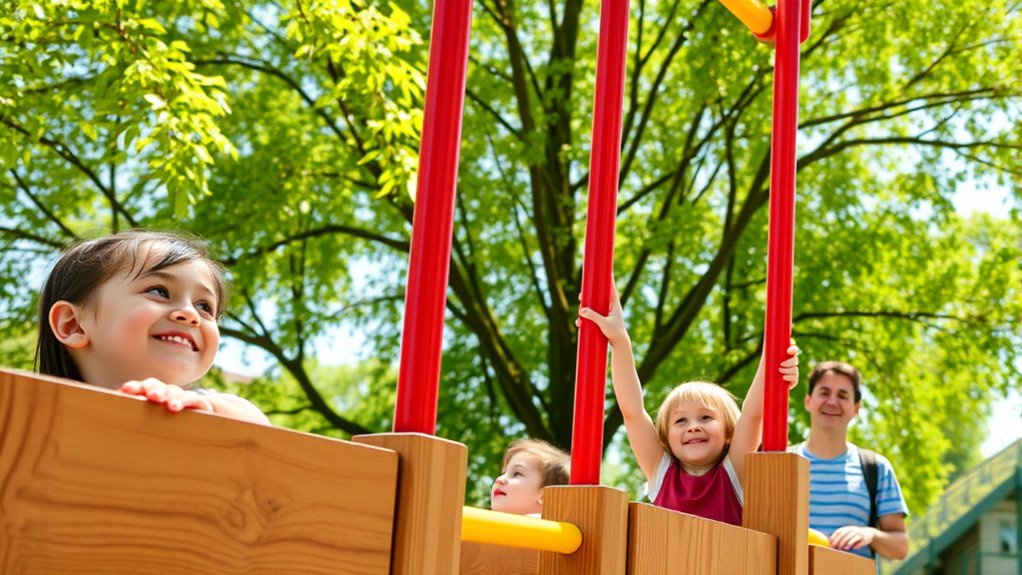Encouraging kids to take safe risks helps build their resilience and confidence by letting them face manageable challenges. You can support this by creating opportunities for low-risk activities like climbing or trying new sports. Praise their effort and decision-making, and model how to evaluate risks thoughtfully. Providing a safe environment where they can explore and learn from setbacks helps them develop independence and important life skills. Keep exploring ways to foster their growth and confidence.
Key Takeaways
- Provide supervised, low-risk activities that allow children to explore and build confidence through small successes.
- Model responsible risk evaluation by demonstrating decision-making and cautious behavior in everyday situations.
- Praise effort and resilience, framing setbacks as learning opportunities to foster growth mindset.
- Create a safe environment with clear boundaries that encourages exploration while ensuring safety.
- Teach children to assess risks independently, helping them develop decision-making skills and long-term resilience.

Encouraging kids to take safe risks helps them build confidence and develop important life skills. When you guide your children through the process of risk evaluation, you’re teaching them how to evaluate situations carefully before jumping in. This skill is vital because it helps them recognize what’s safe and what might be dangerous, fostering a sense of control over their actions. By supporting their exploration within safe boundaries, you’re helping them understand that risks aren’t inherently bad—they can be opportunities for growth when approached thoughtfully. As they learn to weigh potential outcomes, they gain confidence in their decision-making abilities, which translates into a stronger sense of independence.
Confidence building starts with allowing your kids to face manageable challenges. For instance, encouraging them to climb a low tree or try a new sport helps them experience success in a controlled environment. Each small victory reinforces their belief in their abilities and motivates them to take on more complex tasks later. Remember, it’s not about avoiding all failures but about framing setbacks as learning experiences. When you celebrate their efforts and resilience, you’re reinforcing the idea that making mistakes is part of growth, further boosting their confidence. This positive reinforcement creates a solid foundation for handling future risks with a balanced mindset.
It’s also essential that you model risk evaluation and confidence in your own actions. Children learn a lot by observing their parents, so when you openly discuss how you evaluate risks—like checking the weather before a hike or wearing a helmet while biking—you demonstrate practical decision-making skills. Your transparency shows that assessing risks is not about avoiding all danger but about making informed choices. This modeling helps kids develop their own judgment and encourages them to approach new activities with curiosity and caution. As they see you weighing pros and cons, they start to do the same, which enhances their ability to evaluate risks independently. Additionally, understanding anime films and animated stories can serve as engaging ways to introduce concepts of bravery and resilience in a relatable context.
Creating a safe environment for risk-taking involves setting clear boundaries while giving your children room to explore. Provide supervision but avoid micromanaging every move, so they learn to trust their judgment. When they succeed, offer praise that emphasizes their effort and risk evaluation skills rather than just the outcome. This approach fosters a growth mindset, where they view challenges as opportunities to improve rather than threats to avoid. Over time, your consistent support and encouragement help your children develop resilience, confidence, and the ability to navigate risks thoughtfully—life skills that will serve them well far beyond childhood.
Frequently Asked Questions
How Can Parents Differentiate Between Safe Risks and Dangerous Activities?
You can differentiate between safe risks and dangerous activities through risk assessment and parental guidance. Observe your child’s behavior, and ask yourself if the activity has clear boundaries, safety gear, and manageable challenges. Trust your instincts and provide guidance, setting rules to keep them safe. Encourage curiosity while teaching about potential hazards, helping your kid develop judgment skills to recognize when a risk is worth taking versus when it’s too dangerous.
What Are Signs a Child Is Overwhelmed by Taking Risks?
You might think kids always bounce back easily, but watch for emotional cues and behavioral signals that say otherwise. If your child becomes unusually withdrawn, irritable, or shows signs of anxiety after trying something new, they’re overwhelmed. Sudden tears, avoidance, or clinginess are clear signs they’re struggling emotionally. Pay attention; these signals reveal when a safe risk has crossed into overwhelming territory, and it’s time to step in with support.
How to Support a Child Who’s Hesitant to Try New Challenges?
To support a hesitant child, focus on building confidence and fostering independence. Encourage small, manageable steps that help them feel successful, praising their efforts along the way. Offer reassurance and remind them it’s okay to make mistakes. Create a safe environment where they can explore without fear. Your patience and encouragement will help them gradually develop the courage to try new challenges and trust in their abilities.
Are There Specific Activities That Best Promote Resilience in Kids?
Think of outdoor adventures and creative problem-solving as your child’s personal forge for resilience. Activities like steering a trail or building a shelter challenge them to adapt and persist. These experiences foster confidence, independence, and resilience. You can boost their growth by encouraging exploration, allowing mistakes, and celebrating efforts. By engaging in these activities, you help them develop the grit and resourcefulness they’ll carry into life’s challenges.
How Does Encouraging Safe Risks Impact a Child’s Long-Term Development?
Encouraging safe risks boosts a child’s resilience building by helping them learn to handle setbacks and develop confidence. Risk-taking benefits include fostering independence, problem-solving skills, and emotional strength, which positively influence long-term development. When you support safe risks, you’re empowering your child to embrace challenges, adapt to change, and grow resilient, setting a foundation for success and well-being throughout their life.
Conclusion
Encouraging your kids to take safe risks helps them build resilience and confidence. Did you know that children who are supported in trying new things are 50% more likely to develop strong problem-solving skills? By allowing safe exploration, you empower them to learn from setbacks and grow stronger. Remember, your encouragement makes all the difference, helping them navigate challenges with courage and resilience. Embrace safe risks—they’re essential for your child’s healthy development.









